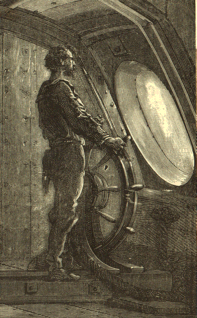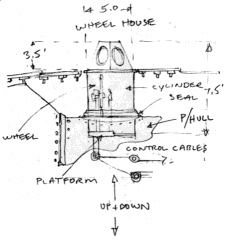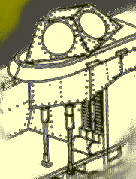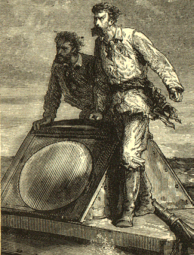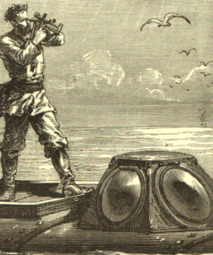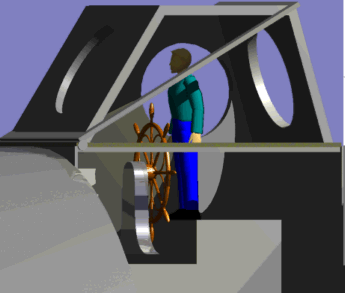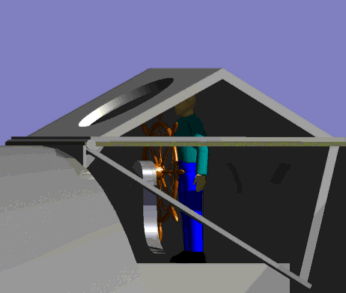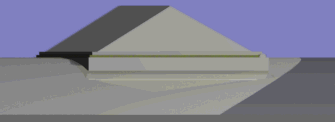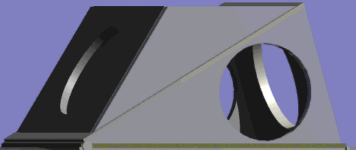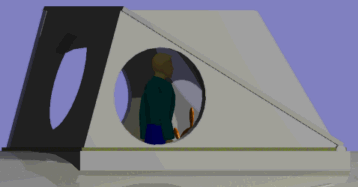|
Le
capitaine Nemo me conduisit vers l'escalier central. A mi-rampe, il ouvrit
une porte, suivit les coursives supérieures et arriva dans la cage du
pilote, qui, on le sait, s'élevait à l'extrémité de la plate-forme.
C'était
une cabine mesurant six pieds sur chaque face, à peu près semblable à
celles qu'occupent les timoniers des steamboats du Mississipi ou de
l'Hudson. Au milieu se manoeuvrait une roue disposée verticalement,
engrenée sur les drosses du gouvernail qui couraient jusqu'à l'arrière
du Nautilus. Quatre hublots de verres lenticulaires, évidés dans les
parois de la cabine, permettaient à l'homme de barre de regarder dans
toutes les directions.
Cette
cabine était obscure ; mais bientôt mes yeux s'accoutumèrent à cette
obscurité, et j'aperçus le pilote, un homme vigoureux, dont les mains
s'appuyaient sur les jantes de la roue. Au-dehors, la mer apparaissait
vivement éclairée par le fanal qui rayonnait en arrière de la cabine,
à l'autre extrémité de la plate-forme.
«
Maintenant, dit le capitaine Nemo, cherchons notre passage.»
Des
fils électriques reliaient la cage du timonier avec la chambre des
machines, et de là, le capitaine pouvait communiquer simultanément à
son Nautilus la direction et le mouvement. Il pressa un bouton de métal,
et aussitôt la vitesse de l'hélice fut très diminuée.
...
Le capitaine Nemo ne quittait pas du regard la boussole suspendue dans la
cabine à ses deux cercles concentriques. Sur un simple geste, le timonier
modifiait à chaque instant la direction du Nautilus.
Je
m'étais placé au hublot de bâbord, et j'apercevais de magnifiques
substructions de coraux, des zoophytes, des algues et des crustacés
agitant leurs pattes énormes, qui s'allongeaient hors des anfractuosités
du roc.
|
Captain
Nemo led me towards the central staircase; half way down he opened a door,
traversed the upper gangways,
and arrived
in the pilot's cage, which it may be remembered rose at the end
of the platform. It was a cabin measuring six feet square, very much like
that occupied by the pilot on the steamboats of the Mississippi or Hudson.
In the center was a wheel, placed vertically, and attached
to the tiller-rope, which ran to the stern
of the Nautilus. Four portholes
with lenticular glasses, mounted
in the cabin walls,
allowed the man at the wheel to see in all directions.
This
cabin was dark; but soon my eyes accustomed themselves to the darkness,
and I saw
the pilot, a strong man, with his hands resting on the spokes of the
wheel. Outside, the sea appeared vividly lit up by the lantern, which shone
from behind
the cabin at the other end
of the platform.
"Now,"
said Captain Nemo, "Let us seek
our passage."
Electric
wires connected the pilot's cage with the engine
room, and from there the Captain could simultaneously
communicate
the direction and
the speed to his Nautilus. He pressed a metal button,
and at once the speed of the screw decreased.
...
Captain
Nemo did not take his eye from the compass,
suspended in the
cabin in its two concentric rings.
At a simple gesture, the pilot modified the course of the Nautilus at
every moment.
I
had placed myself at the
port-side porthole,
and saw some magnificent
substructures of coral, zoophytes, seaweed, fucus, and shellfish agitating
their enormous claws, which stretched out from the fissures of the rock.
|
